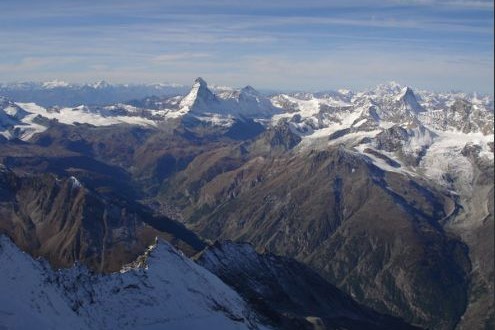The Matterhorn is the ultimate mountain. It is the world’s most photographed peak and is a legend and an emblem for climbers and photographers. It is Switzerland’s greatest landmark and a symbol. Thanks to its shape and its free-standing position, the Matterhorn is considered to be the epitome of a mountain. There is no better known mountain in the world whose natural shape is so close to a pyramid. 100 million years ago, enormous forces brought Africa closer to Europe and 50 million years later, as the rock masses folded and deformed, the Matterhorn was born from the rock thrusting upwards. The Matterhorn is first mentioned in medieval documents as “Mons Silvus”. The name later mutated into “Mons Servinus” and “Mons Servin”, and finally became “Cervin” in French and “Cervino” in Italian. The Matterhorn was first referred to in writing as “Mont Cervin” in 1581, and later also as “Monte Silvio” and “Monte Servino”. The German named “Matterhorn” first appears in the year 1682. The name is probably derived from “Matte” which means meadow, referring to the grassy extended valley under the Gornder gorge, which has now been almost completely covered by the village of Zermatt. The mountain is also known by the locals as “ds Hore” or the peak in Zermatt dialect.
The story of the first ascent is probably one of the most famous stories told in Zermatt. On July 14th 1865 Edward Whymper and his fellow climbers succeeded to hike up the summit but a tragic accident took place leaving four climbers to loose their lives. Despite the tragedy, due to the successful ascent, the Matterhorn became very famous and popular. From then, many visitors and hikers visited Zermatt to take a look at the magnificent Matterhorn and to also challenge the hike up the summit. The Matterhorn is not a very difficult mountain to climb but the weather and the crevasses is very dangerous taking many hikers and climbers lives. Between 1865 and the end of the summer season 2011, an estimated 500 climbers died on the Matterhorn. Every year, between 300 and 400 people attempt to climb the peak with a guide and of them, about 20 fail to reach the summit. Roughly 3500 people tackle the Matterhorn without a guide each year, some 65% turn back en route, usually because of lack of fitness or an insufficient head for heights. Poor weather also often plays a role, conditions up in the mountain change very quickly. Since fixed cables were installed on the upper section of the Matterhorn in the 1980s, the number of mountaineers who lose their lives on the peak has fallen. Every year, in early summer, the installations are checked and repaired. A new challenge has arisen in recent years, melting of the permafrost which has increased the risk of rockfall.

